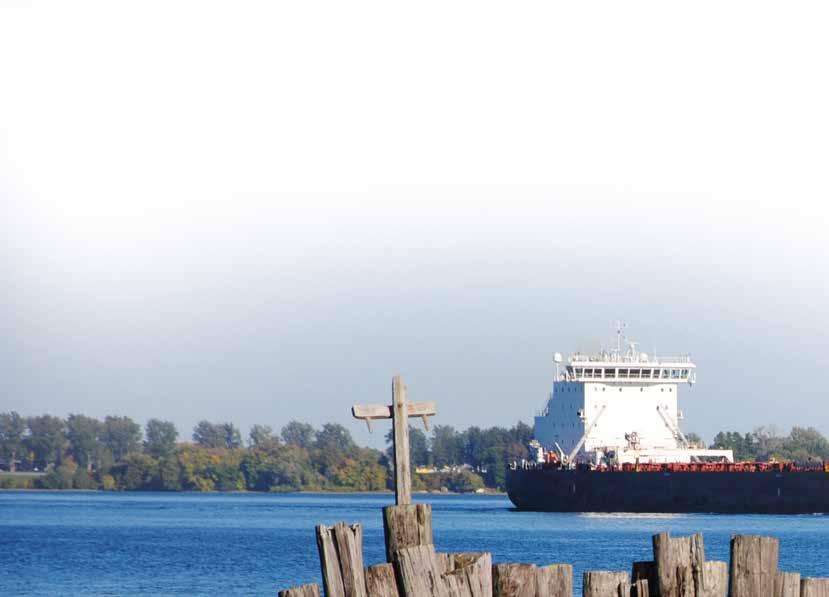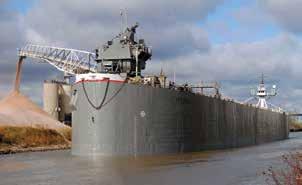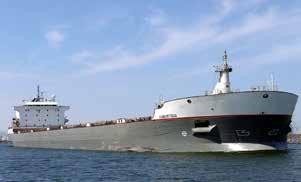
7 minute read
POLICY
SHIPPING CALLS FOR HIGH WATER SOLUTIONS THAT PROTECT SEAWAY TRADE CORRIDOR BY JULIA FIELDS
High water levels are wreaking havoc across the Great LakesSt. Lawrence region, damaging shoreline residential, business and port infrastructure and threatening the operation of the bi-national trade and transportation corridor – the St. Lawrence Seaway.
During the past year, the rising water levels have continuously led to calls to “open the floodgates” at one dam on the St. Lawrence Seaway to lower Lake Ontario levels. This move would create fast-moving, unsafe currents that would stop marine shipping and cost the Canadian and American economies up to USD $193 million (CAN $250 million) lost business revenues per week – impacting farmers, steel and manufacturing employees, miners and construction workers and the myriad of others whose livelihoods depend on the cargo carried on the waterway.
Moses-Saunders dam has little impact on high water problem Scientific evidence from the International Lake Ontario-St. Lawrence River Board demonstrates that outflow levels at Moses-Saunders dam have little impact on the problem, lowering the Lake by centimetres only to have more water come flooding in from Lake Erie and the other overflowing Great Lakes.
During the winter months, the River Board let out as much water as
it could without impacting municipal water intakes, engineering works and causing ice jams. Much of that progress was wiped out by two days of heavy rainfall. Any outflow increase at this dam increases water levels in Montreal (which are also impacted by water from the Ottawa River), and also draws down water levels on Lake St. Lawrence, where extremely low water levels are expected to return. With all the different stakeholders at risk there is often very little room to manoeuvre. The River Board had to adjust outflow levels 28 times just in January. “It’s time for politicians to start working with all the affected stakeholders on smart, effective solutions for high water levels. Shutting down or interrupting Canadian, American and international trade on the St. Lawrence Seaway and further damaging the economy and our nations’ global trading reputation should never be an option,” says Bruce Burrows, President and CEO of the Chamber of Marine Commerce.
Twenty-five per cent of all Canadian grain exports transported on bulk vessels travel through the Great Lakes-St. Lawrence River waterway. U.S. and Canadian industries specifically located their mines, plants and grain terminals on the waterway and have organized their entire supply chains around using marine shipping to transport huge volumes of materials and products within North America and to and from overseas. With one Seaway ship able to carry as much as 963 truck loads, marine shipping is both the most cost-efficient and environmentally-sound option. For many mines, quarries and steel and other manufacturing plants – there is no alternative transportation infrastructure network waiting in the wings.
“These businesses will be scrambling to find thousands of trucks to fill the gap at extra cost and/or dealing with shortages and lost business,” says Burrows. “With ships producing 500% less carbon per tonne kilometre than trucks, the sad irony is that interrupting Seaway shipping would actually contribute to exacerbating the problem that many scientists are linking to the huge swings in precipitation in the Great Lakes – climate change.”
Marine shipping is already feeling the pain of high water In 2019, marine shipping worked diligently with stakeholders for a solution to ensure safe navigation at record outflow levels from Moses-Saunders dam for five months to help lower Lake Ontario, taking on 26 mitigation measures that caused shipping delays, lost cargo business and millions of dollars of extra operating costs. Throughout the winter, the Chamber has been working with ship captains, the St. Lawrence Seaway and experts in Canada and the United States to identify technology and further mitigation measures that
could be tested to potentially allow safe navigation to continue at higher outflow levels in the coming season. Despite these efforts, the River Board said it would raise outflow at the dam to unsafe navigation levels, forcing the opening of the Montreal-Lake Ontario section of the St. Lawrence Seaway for shipping to be delayed to April 1 this year. With little ice coverage, Seaway shipping could have started March 20, with as many as 100 ship transits taking place during that 12-day delay.
Calls for action Moving forward, the Chamber is recommending the following actions: • For the IJC and governments (federal, state and provincial) to work with all stakeholders on an action plan that looks at all avenues including shoreline resiliency, flood management zones and other infrastructure investments for residential and business owners. • That the IJC use scientific data to measure the benefit to shorelines of any proposed actions and that these water reductions not cause further harm to the U.S. and Canadian economies. • That the ILORB include commercial navigation interests as members, as recent appointees have been made that represent shoreline interests. • That investments be made in marine infrastructure to better inform commercial navigation when outflows are high and currents are fast, including current meters, shoreline mapping and other tools.
STAKEHOLDERS ON THE CONSEQUENCES OF INTERRUPTING ST. LAWRENCE SEAWAY COMMERCIAL NAVIGATION “It disrupts our ability to supply our international customers. Vessel demurrage charges, contract extension penalties and contract defaults are real consequences, as is harm to Canada’s reputation as a reliable supplier of grains, oilseeds and pulse crops throughout the world. We are extremely sensitive to these extra costs, not only for our members but for grain producers and customers. A disruption to the grain supply chain of any length of time means lost shipping opportunities that will never be recovered.” Wade Sobkowich, Executive Director of the Western Grain Elevator Association (WGEA), representing major grain businesses handling in excess of 95% of western Canada’s bulk grain exports.
“It’s important to understand that ships delivering and shipping goods from Great Lakes ports like the Port of Toledo, Ohio are part of a supply chain linking the Midwest to global markets. A disruption in the supply chain would have considerable ripple effect in the many industries we serve including U.S. steel production, aggregates for construction, energy generation, and agricultural exports. Often there are no alternative routes to deliver these commodities.” Thomas Winston, President & CEO, Toledo-Lucas County Port Authority
“The result of such action would be transportation chaos with negligible benefits. A mid-season shutdown of as little as 20 days would send manufacturers and farmers scrambling to find alternative transportation for as much as a million tonnes of cargo at our two ports. If port users could even find alternative transportation, it would likely be a truck, resulting in more than 40,000 new truck trips between the Greater Toronto-Hamilton Area and Montreal at a 500% increase in carbon emissions.” Ian Hamilton, President and CEO of HOPA Ports (Hamilton-Oshawa Port Authority)

“Raising water outflows to levels that would force navigation stoppages or cut the season short would be detrimental to our business. LafargeHolcim relies on Seaway shipping to bring raw materials in from overseas for cement production — materials not available in the U.S. or Canada. Seaway shipping is also the most cost efficient and environmentally sound way for us to transport large volumes of construction materials which are used to build everything from buildings to roads, bridges and airport runways. LafargeHolcim depends on having reliable, uninterrupted transportation on the St. Lawrence Seaway to produce products that serve our customers, which are ultimately people living and working in the Great Lakes-St. Lawrence region.” Chuck Hriczak, Marine Operations Manager, Great Lakes & East Coast/ LafargeHolcim U.S.



Delivering More
Rand Logistics, Inc. is a leading provider of marine bulk freight shipping, ship repair and logistics services throughout the Great Lakes region. Through our fleet of fifteen U.S. and Canadian flagged vessels and our team of dedicated professionals, we provide unique and comprehensive supply chain solutions to the marketplace. We take pride in our world class safety record, exemplary maritime and technical expertise, and the unmatched efficiency and flexibility of our operations. We are the only carrier that offers significant domestic port-to-port services in both Canada and the U.S. on the Great Lakes, and due to the versatile and diverse makeup of our fleet, the only carrier that can access every commercial port in the region. Contact us for more information about how Rand Logistics and our subsidiary companies can help you with your supply chain needs.
Lower Lakes Towing, Ltd. 517 Main Street Port Dover, Ontario, CA N0A 1NO Phone: 519-583-0982 Grand River Navigation Company 1026 Hannah Avenue, Suite D Traverse City, Michigan, USA 49686 Phone: 231-642-4622
Rand Logistics, Inc. 333 Washington Street, Suite 201, Jersey City, New Jersey 07302 Phone: 212-863-9403 www.randlog.com
Conneaut Creek Ship Repair 4200 Benefit Avenue Ashtabula, Ohio, USA 44004 Phone: 440-990-3051










